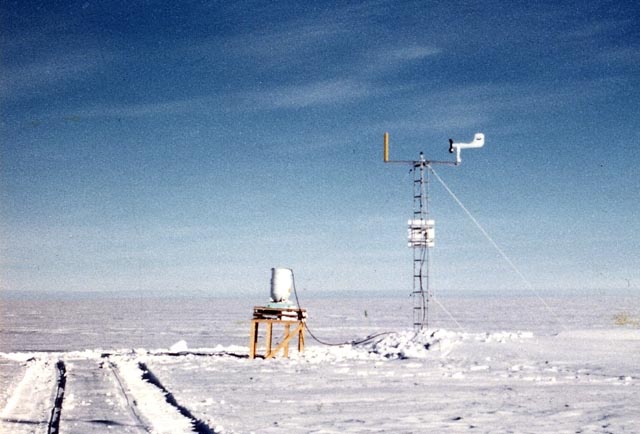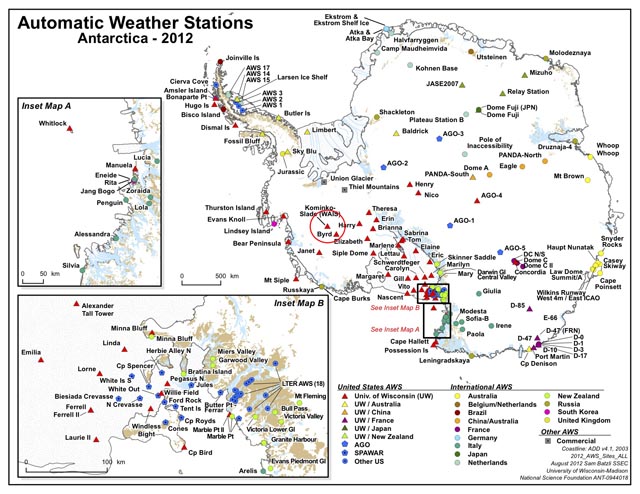|
Trending upWeather data show West Antarctica heating up over last 50 yearsPosted December 28, 2012
West Antarctica is heating up and is among the most rapidly warming regions on the planet. That’s the conclusion of a team of National Science Foundation The data show that average near-surface temperatures have risen by 2.4 plus/minus 1.2 degrees Celsius between 1958 and 2010. “We’re speculating that the surface of West Antarctica could start looking like Greenland [does] today,” said David Bromwich Climate change in the polar regions has been particularly strong in the Arctic. In July 2012, satellites showed 97 percent surface melt across Greenland for four days. A major study published in November 2012 in the journal Science found that the rate of melting for the ice sheets covering Greenland and Antarctica has tripled since the 1990s, with two-thirds of the loss coming from the former, and the remainder coming primarily from West Antarctica. 
Photo Credit: AMRC/SSEC/UW-Madison
An automatic weather station was installed at the Byrd site in 1980.
West Antarctica is mostly a marine-based ice sheet, with the bedrock more than a kilometer below the surface of the water. It’s more vulnerable to climate change than the East Antarctic Ice Sheet, which is much thicker and sits mainly on bedrock above sea level. The Transantarctic Mountains divide the two ice sheets. Warming across a third region of the continent, the Antarctic Peninsula, which juts out toward the southern tip of South America, has been well documented. Average near-surface temperatures have climbed 3 degrees Celsius in the last five decades — and about double that during the winter months. However, the Nature Geoscience paper is the first to show a large warming trend in West Antarctica. But it wasn’t an easy job, according to Bromwich. “It took a lot of effort for us to do, and there was a substantial amount of detective work involved in this,” he explained. The temperature record combines observations from the Byrd research station that was staffed from the 1950s to the 1970s with data collected from an automatic weather station (AWS) that had been in installed in 1980 by meteorologists from the University of Wisconsin-Madison’s Antarctic Meteorological Research Center (AMRC) 
Photo Credit: AMRC/SSEC/UW-Madison
Map of AWS sites around Antarctica. Byrd Station is circled in red.
About 30 percent of the record was missing. There were some gaps in the 1970s after Byrd Station became a summer-only facility. The installation of the AWS again provided year-round measurements. Initially, power was reliably provided by a radioisotope thermoelectric generator (RTG). The continent went nuclear-free before the end of the 1980s, and the AWS site was then powered by less reliable batteries and solar panels. “There are lots of gaps in this automatic weather station record subsequent to [switching power sources],” Bromwich said. “It’s messy. That’s the problem with the observations from Byrd Station.” To address this challenge, the researchers relied primarily on temperature estimates from a certain type of atmospheric model known as a global reanalysis. A reanalysis is similar to a model used to forecast the weather, which uses a variety of observations to constrain the initial model condition. The weather model is then played forward to predict the weather. The reanalysis model also relies on meteorological observations to produce a model analysis that mirrors reality. However, it reconstructs the state of the atmosphere in the recent past using historical observations. Byrd Station was used because it was the only site with a long enough historical record. There are about 18 AWS sites in West Antarctica maintained by AMRC today. However, none were installed before 1992 except for the Byrd site. “This network is very valuable, and becoming more so as we move into the future,” said Matthew Lazzara Lazzara said there are a number of challenges in operating the weather station network, which today consists of nearly 70 stations maintained by AMRC. Many of the sites are in remote, difficult-to-reach locations. Funds to upgrade hardware are limited. And weather is a constant foe in terms of causing equipment failure and delays in reaching stations for needed repairs. “With a desire to have expanded observing at any one site, there are limits on the power available without increasing the logistic cost,” Lazzara noted. “One of the many successes of the AWS program has been very low power needs to get the measurements we and so many other researchers need.” The source of the warming in West Antarctica varies by season, according to Bromwich, but it involves changes in atmospheric circulation that transports more heat from lower latitudes to West Antarctica. Previous research has linked such changes to climate variability in the tropical and subtropical Pacific, along with the depletion of stratospheric ozone and increased greenhouse gases. “It’s one of the more complicated parts of Antarctica,” Bromwich said. “The importance of this record is what it tells us about what’s happening in the atmosphere around West Antarctica as a whole. It’s not really the melting at Byrd per se, but what it implies for melting of lower elevation parts of West Antarctica.” Melting on the scale of Greenland hasn’t happened in West Antarctica yet. However, in 2005, satellites detected liquid water from Byrd Station to the Ross Ice Shelf, hundreds of kilometers away. “That’s the most dramatic example that I’m aware [observed] from space,” Bromwich said. Such scenarios could become more common in the future. “Climate change is affecting the Antarctic Peninsula and West Antarctic Ice Sheet,” he added. “We’re much more confident of that now.” NSF-funded research in this story: David Bromwich and Keith Hines, The Ohio State University, Award No. 0751291 |



For USAP Participants |
For The Public |
For Researchers and EducatorsContact UsNational Science FoundationOffice of Polar Programs Geosciences Directorate 2415 Eisenhower Avenue, Suite W7100 Alexandria, VA 22314 Sign up for the NSF Office of Polar Programs newsletter and events. Feedback Form |



